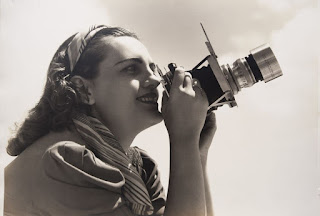I got a note recently from Randy at Holgamods to tell me that he has added
Brownie Hawkeye Flash modifications to the services he offers.
The two modifications that offer the most added value in using this great old box in my opinion are the addition of the cable release and the tripod mount. However, Randy also can provide a number of other functional and cosmetic enhancements for the bakelite wonder. I haven't seen his work in person, but the many illustrations on his site show some very high quality work.
Kodak film cameras were the target of a lot of derision in years past, but I think there is pretty wide-spread agreement these days that the Brownie Hawkeye Flash represents one of the high water marks in mid-Century American design. The rounded contours of the fluted bakelite case make it a pleasure to handle, and the ultra-bright viewer is a treat for the eyes.
The meniscus lens can produce crisply sharp images, but only if you really concentrate on making sure the camera remains completely steady during the exposure. That is something of a challenge given the shape of the box, as well as a rather stiff shutter release. Also something of a mystery is the prominent time-release setting tab unaccompanied by a built-in cable release or tripod socket.
My guess is that Kodak marketing decided the flash feature on the camera was going to be the real selling point. That was probably justified, and I do recall burning my fingers on freshly ignited bulbs a few times with my first BHF in the mid-'50s. There was a flash hood that came along with the flashgun, with one side clear and the other translucent to cut down the glare a bit. In the case of a bulb malfunction, the hood also helped to avoid showering your subject with burning bits of glass and toxic metals.
Though they weren't part of the basic boxed kit, a number of accessories were available for the Hawkeye Flash. Red, yellow and UV filters allowed some contrast control for better skies, as well as providing the possibility of several stops of exposure control in a camera without a variable aperture. I've only used filters on mine a few times, but I have made quite a few pictures with the No. 13 Close-up Attachment which lets you focus down to about 3.5 feet, and is particularly nice for portraits.
I've mostly shot 100-speed black-and-white film in
my Hawkeye Flash, but it is capable of producing great color slides and prints as well. While some of the cameras can accomodate 120 film, most will require either that you trim down a 120 reel, or re-roll your 120 film onto an old metal 620 reel. In either case, you'll need a 620 reel in the take-up position. I re-rolled some Acros 100 for my Hawkeye Flash this morning and am half-way through the roll at present. We'll see if I manage to get something presentable in short order.
UPDATE:
Randy has continued to make additions to his
Hawkeye Mods site. Recently, he added a tutorial on reversing the lens in your Hawkeye Flash. This is a procedure that can be accomplished in a matter of minutes, and produces really striking images from this great old box camera.







































